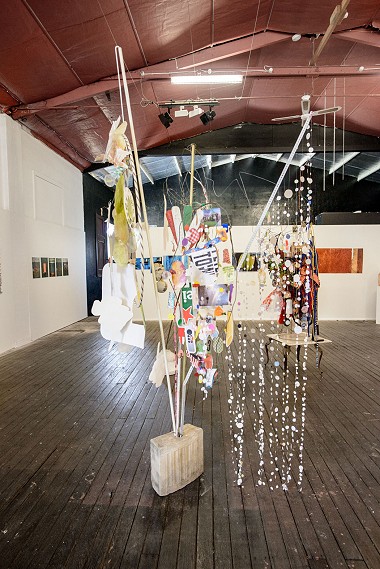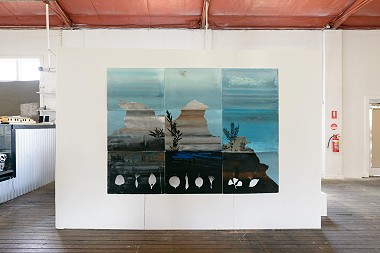Something interesting happens when you combine the certainty of print with the ephemera of time. You take the enduring solidity of the traditional medium, with time itself - the very substance of ephemerality. The print media becomes fleeting and unpredictable; the artist could go in any direction from here.

Beyond Remorse and Stone Circle 2021 by Patricia Wilson-Adams
The ‘hybrid print’ doesn’t seem like such a big deal, but printmaking is a centuries old tradition that has meticulous methodologies (evolved over those centuries) to create perfect editions. Printmaking is the process of transferring images from one matrix to a surface, generally paper or fabric. The plate is made from a hard surface like wood, metal or glass, using ink to transfer an edition of an image cleanly onto its new surface usually using some kind of press (with the exception of monotypes and silk screen printing). To be done properly and safely, it’s a technical process that involves precision and understanding of the media being used; the inks can be sticky, messy and not water soluble, the chemicals often toxic. The key aspect of printmaking is that there can and probably will be future reproductions. There is a sense of solidity; the plate is seen as the constant matrix that will reliably give you the same image over and over, the artist is the variable; it’s she who will make the mess.

non-stop matterings 2022 by Sandra Winkworth
WAYOUT: with Print, curated by Linda Swinfield is part of an ongoing exploration into the deviation of print as a traditional medium. Bill Meyer’s 1985 exhibition Print as Object was the first: a groundbreaking, controversial travelling show that would inspire art schools to expand their subject range to include Print as Object, a digression from the traditional media. Therese Kenyon and Patricia Wilson-Adams curated a 2020 exhibition at Maitland Regional Art Gallery, Let All the Birds Fly: the Hybrid Print.

Plant, Pagoda, Carbon 2021 by Freedom Wilson
This expansion of the idea of printmaking is taken up by Sandra Winkworth’s mobile installation of found print media. Objects found on her walks around her hometown exploit the fact that printmaking is everywhere. In our modern society, any room you walk into will be home to some form of print media: newsprint, photos, signs, packaging, documents. Unfortunately though, being who we are, these ubiquitous items are most often left for trash; strewn, in this case, through the Blue Mountains bushland for Winkworth to collect. Part of the Heineken star for example. A token logo, printed millions of times since its creation; barcodes that convey specific information about objects that probably don’t exist anymore, dangling decoratively in the breeze.

various works (2019-22) by Jan Melville
Jan Melville’s Printed within, 2022 turns printed objects; pages of books and artworks depicting flora and fauna, alongside found flowers, leaves, bones eggs nests. She’s referencing the cycles of life and the experience of the black summer bushfires; a brief but enduring period in the Australian consciousness. Like Winkworth, Melville collects things on her walks that reference human intervention, but in this case the effect of humans on the environment, specifically what they are doing to our flora and fauna. These ecosystems were imperishable until we got here. Situated across the way is Patricia Wilson-Adams poems ‘to the pebbles and her Coptic bound prayer books, weighed closed with stones. The cycle of it all becomes visible.
- Lucy Smith 2022

Cockatoo Island surfaces and remnants 2022 by Therese Kenyon
In Skins, 2020, a single channel-video, we can see Ben Rak cover his face with collaged silkscreen print media in eight different but seemingly commonplace settings. It seems like he’s trying to hide. This video is next to his Becoming #2, a silk screen print of a human head that is obscured by what looks like collaged silk screen print, all but the clearly discernible eyes. It seems like he’s hidden himself from us, prior to engagement.

Becoming #2 and Skins by Ben Rak
Linda Swinfield, with multiple layers of images of landscapes, has created a nostalgia specific to a family, in this case, the Webbs, who grew up in and around the asbestos ridden Wallerawang power plant. Her photo albums, full of multiple exposure photographs of the area, are indistinguishable but familiar even to someone who hasn’t spent time there, like you’re flipping through pages of memories. The artist has made use of the lines in the images, undoubtedly recognisable to anyone who has spent significant time in Wallerawang, but evoking this familiarity as a formal abstraction for those without this actual experience. It’s impossible not to wonder what these memories are.

Fire in the Mountains 2021 by Anthea Boesenberg
Fleeting time should be such a simple concept. Every November you get shocked by where the year could have possibly gone. The industrial revolution was a blink of an eye ago, the Heineken star will last longer than Sidney Webb’s memory; but it’s worthy to note that all of the artists in this exhibition have grasped a second, a decade, a century and brought those moments closer to perpetuity.
- Lucy Smith 2022

A page from Sydney's Album 2019-20 by Linda Swinfield
